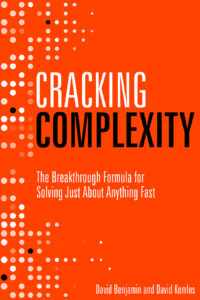Simplicity in the Age of Complexity
“The answer is simple,” the professor said, then he waited a minute and added the important qualifier, “if you are a mathematical genius.”
He was attempting to explain one of the most complex concepts of the semester. I remember laughing along with the class as we struggled to make sense of it at all.
In business, I often wonder if there are any simple problems. We are living in a world that is complex, full of ambiguity and more difficult to navigate.
That’s why I was interested to see how David Komlos and David Benjamin tackled the subject. Their new book is Cracking Complexity: The Breakthrough Formula for Solving Just About Anything Fast. David Komlos is CEO of Syntegrity and David Bejamin leads Syntegrity’s client delivery organization.
Solving Complex Problems
What defines a complex problem?
Complex problems are messy, unstable, unpredictable, confounding and don’t come with right answers, only best attempts. These problems require new solutions created specifically for the circumstances, and you can only know that you’ve found a good one in retrospect. Contrast that with complicated challenges which are the domain of the expert: a known solution exists, and it can be reliably and successfully applied as needed by someone who knows what they’re doing.
Building a fence between your yard and a neighbor’s yard is a complicated challenge; building a great relationship with your neighbor is complex. Fixing a car is complicated; disrupting the automotive industry is complex. Implementing a customer relationship management system is complicated; delivering a winning customer experience every time is complex.
10 Steps to Solving Complexity
You list 10 simple steps to solving complexity. Which step trips leaders up more than others?
Leaders tend to get tripped up on the early steps, and when that happens it means they don’t even get to the point where they’re trying to implement the later ones.
In step 1 – acknowledge the complexity – leaders often don’t see the difference between complicated and complex, so they can’t acknowledge it. All they know is that some challenges tend to get solved, and some don’t. This leads to the wrong conclusion – if going to the experts to solve some problems (i.e. the complicated ones) works, it makes sense to go to them to solve all of them. Since the complex ones are categorically different, the experts and the expert-centric model of solving problems is the wrong approach.
Even when leaders do recognize and acknowledge that this problem is different, steps 2 and 3 are where they’ll tend to devote much less attention than they should, and these steps are also foundational. Step 2 is about framing the complexity in a great question, and step 3 is about getting all the right people involved in answering that question.
Instead of a great, clear, compelling, aspirational question – which takes work – they’ll tend to do some problem definition, have a report written, and use this as a starting point. This easily leads to miscommunication, misunderstanding and misalignment (from the start) about what the problem is, what success looks like, why it matters, and what’s at stake.
And instead of assigning a high-variety group from inside and around their organization to develop solutions, they’ll tend to go to the usual suspects, keep the group small, and rely on what they see, know and believe (which, with complex problems, isn’t nearly enough).
The Power of Questions
Let’s talk about questions. Talk about the power of a good question to crack complexity.
“A really, really good question will launch a thousand really, really good conversations” – nobody actually said that, but someone should have.
By ‘a really, really good question’, we mean it should:
- Engage all the right people and catalyze great conversations;
- Give boundaries to the problem without biasing or unnecessarily constraining the answers;
- Call for action, name who will act, and convey a sense of urgency for action and for results; and
- Set an aspirational stretch goal that is within reach, but only if things change.
When it comes to cracking complexity, you have to flip convention on its head and ‘boil the ocean’ – deal with all its facets all at once – in order to come away with clarity on what matters and what you can do about it. A really, really good question has the power to be your anchor in that boiling sea of doubt.
Without disclosing the source, take this question as an example:
“What must we all start working on now and over the next 18 months to realize year-over-year double-digit growth by 2021 without jeopardizing profitability or employee satisfaction?”
This question spurred frank and difficult conversations about why growth was stagnating, why employee attrition was happening, what it would take to effect real change (to culture, to policies and processes, to the product set, and to the customer experience), and who would have to step up to lead the charge. It also got under people’s skin because double-digit growth wouldn’t allow for the current-course-and-speed plan, and yet the question precluded options like adding significant new resources or overburdening the current workforce. The tight timeframe and “what must we all start working on” clause pushed people from platitudes like ‘working smarter’ or ‘being more innovative’ into concrete actions, including which sacred cow projects to stop.
Tips to Ask Good Questions
What are some tips that can help leaders ask questions more effectively?
Don’t be afraid of how people will react. You are looking for a great dialogue, and you need to challenge your group to do better than they normally do in finding answers. Sometimes, that means angering a few people and even hurting a few feelings. If everything was going as it should, you wouldn’t have to ask the question.
Don’t be afraid of how it looks for you to be asking the question. Are you showing weakness? Are you in over your head? Are you avoiding doing your job? No. By definition, complexity requires the engagement and involvement of a high-variety group that includes you and goes well beyond you. You’re asking the question about what to do because you know what you’re doing when it comes to complexity.
Avoid unintended assumptions and bias. Don’t treat your stated strategy as a given if it’s not. Don’t assume that prior communication has been effective and that people get it. Don’t tell people that the answer lies in insourcing or outsourcing or technology or big data or acquisitions or divestitures… Let them conclude for themselves what the answers are, having explored your broad question, from the universe of possibilities you open to them.
What would you say is different today than past experience in solving complex problems?
What is primarily different today is the size, volume and pace of complex problems. It’s not millennials or Amazon or AI or self-driving cars or cybersecurity or the gig economy or China or … it’s all of those forces, and others, all at once.
Whereas we used to get away with using linear approaches to solve big challenges one at a time and in sequence (“let’s work on business process reengineering this year and next, then move on to implementing an enterprise-wide ERP system, so we can get around to customer-centricity and a CRM platform by year 7…”), that just doesn’t cut it anymore. Too many things are changing too fast.
When organizations approach today’s tsunami of complex challenges the way they used to, they’re likely under water before they’re ready to enact whatever solutions they’ve carefully developed and are just getting ready to deploy. The new requirement is to keep up by taking rapid ‘power leaps’ that result in new solutions in days or weeks, instead of the traditional months or years. From current action plan to new action plan at the pace of change.
“Go slow to go fast”, as the old adage says, but go very fast at “going slow to go fast” if you’re going to keep up.
Translate Plans to Action
You give some specifics on taking insights and translating them into a plan of action. How do leaders best sustain this until achieving the desired outcome?
Insights from the formula can be bucketed into three kinds:
- Things to do – the simple or complicated actions that can readily be executed with good project management and the right team;
- Things to try – the potentially game-changing, risky and promising ideas that represent true innovation, and need to be quickly tried in a few places before being rolled out everywhere (or stopped, if they don’t work); and
- Newly revealed complexities – that next set of complexities you didn’t know were lurking until you successfully unraveled the first complexity.
Each bucket comes with its own distinct approach – namely, respectively: straightforward action-execution; trial-and-error experimentation; and another iteration of the 10-step formula.

Now, how do leaders sustain execution on all three?
Apply these 8 key success factors for execution in the complex domain. They are:
- Sharp focus and commitment to a few clearly identified goals
- Clearly identified “distributed leaders[1]” who are tasked with driving execution
- Shared understanding among “distributed leaders,” cascading effectively to everyone else
- Leadership behavior that exemplifies, recognizes and rewards the right behaviors
- Involvement of people with the right capabilities from in and around the organization
- Keeping score of performance against the right lead measures
- Coordination and optimization across silos
- Experimentation, adaptation of plan and redeployment of resources as you learn.
The good news is that when you’ve approached the creation of solutions to your complex challenge the right way, the process by which you’ve done so is also a down payment on these execution essentials because your group of solvers will:
- Re-articulate and embrace the goals to be shared.
- Include the ‘distributed leaders’ who will have established a shared understanding and will drive execution.
- Establish the required leadership behaviors that all leaders must sign up to.
- Sign up for continued involvement.
- Identify the measures to track.
- Cross the silos and continue to do so.
- Determine what experiments to pursue and how to know when they succeed or fail.
For more information, see Cracking Complexity: The Breakthrough Formula for Solving Just About Anything Fast.
[1] Defined in HBR’s Why Strategy Execution Unravels—and What to Do About It (Donald Sull, Rebecca Homkes, and Charles Sull, MARCH 2015)


